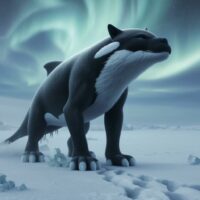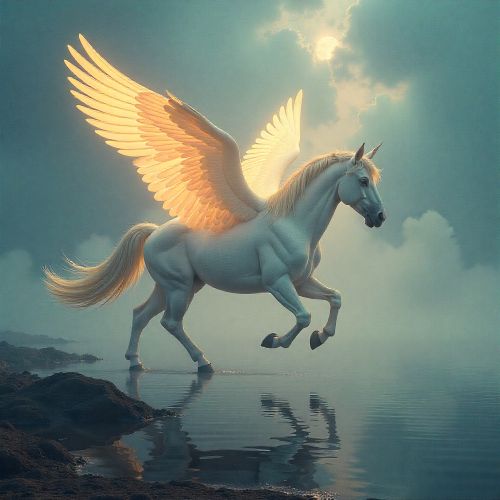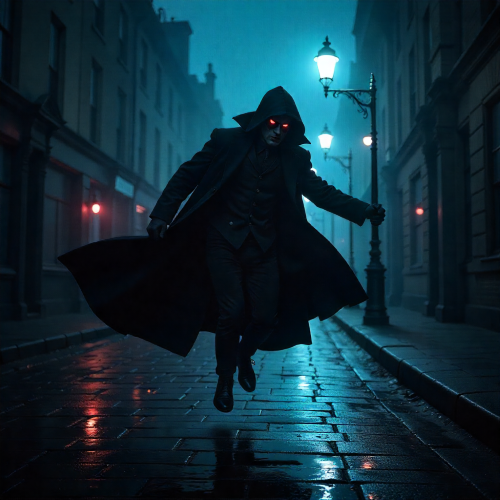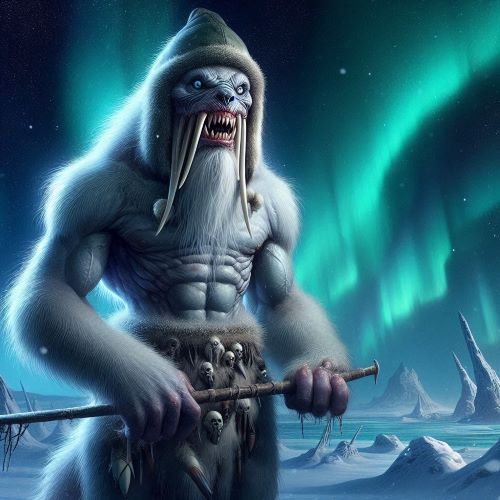Akhlut : The Were Orca
Listen
At a glance
| Description | |
|---|---|
| Origin | Inuit Mythology |
| Classification | Hybrids |
| Family Members | N/A |
| Region | Alaska, Canada, and Greenland |
| Associated With | Shape shifting, Strength, Stealth |
Akhlut
Introduction
The Akhlut is a formidable spirit in Inuit mythology, known for its ability to shift between the forms of a wolf and an orca. More than just a mythical creature, it embodies the raw power and unpredictability of the Arctic landscape. Inuit tales often describe wolf tracks mysteriously disappearing at the water’s edge, fueling the belief in a being that seamlessly moves between land and sea.
Unlike mere hybrids, the Akhlut is considered a spirit that only takes on physical form when active. Its existence serves as both a warning and a lesson, reminding the Inuit of nature’s duality—both beautiful and dangerous. The legend reflects the deep respect the Inuit have for their environment and their understanding of its mysteries. Through generations, the Akhlut has remained a potent symbol of adaptability and survival, reinforcing the values necessary to navigate the harsh Arctic world.
Physical Traits
The Akhlut is a shape-shifting spirit that seamlessly transitions between the forms of an orca and a wolf. In the ocean, it takes on the sleek, muscular body of a killer whale, its dark upper body contrasting with a pale underside. Equipped with a towering dorsal fin and powerful flukes, it moves effortlessly through Arctic waters, hunting with precision.
On land, the Akhlut transforms into a massive, imposing wolf, often described as larger than any ordinary wolf. Its dark fur mirrors the coloring of its orca form, and its glowing eyes add to its eerie, supernatural presence. Some depictions blend the two creatures into a single hybrid form, featuring a wolf’s legs and head with the body of an orca, making it an even more fearsome entity.
This dual nature allows the Akhlut to traverse both sea and ice with ease, leaving behind hauntingly large tracks that vanish at the water’s edge. Whether seen as a warning or an omen, its presence is a reminder of the unforgiving Arctic wilderness and the creatures that inhabit its depths.
Family
The Akhlut is largely depicted as a solitary being in Inuit mythology, emphasizing its independence and dominance over both land and sea. Unlike many legendary creatures with defined familial ties, the Akhlut exists outside of traditional kinship structures, reinforcing its role as a lone predator.
Some variations of the myth suggest that the Akhlut was once human, cursed or transformed due to an obsession with the ocean. Banished by their tribe, they gained the ability to shift between wolf and orca forms, possibly as a means of survival or revenge. This origin story adds a tragic element, portraying the Akhlut as both feared and outcast.
Though primarily depicted as a singular entity, occasional accounts hint at brief alliances, particularly in its orca form, where it may join other whales for hunting before returning to isolation. In more modern reimaginings, the Akhlut has been given a sense of community, sometimes even a family, reflecting a shift in how the creature is perceived—less as a monstrous force and more as a complex being navigating two worlds.
Other names
The Akhlut is sometimes referred to as the “Orca Wolf” or “Feral Hunter,” emphasizing its dual existence in both the sea and on land. In early records, American naturalist Edward William Nelson documented the term kăk-whăn’-û-ghăt kǐg-û-lu’-nǐk, a name used by some Inuit groups to describe this shape-shifting being. In this context, akh’lut was associated with orcas, while kǐg-û-lu’-nǐk referred to the gray wolf.
These various names reflect the Akhlut’s fluid identity and its fearsome reputation. Different Inuit dialects may have their own interpretations, but all capture the essence of a creature that blurs the boundaries between predator and spirit, land and ocean.
Powers and Abilities
The Akhlut is a powerful and enigmatic being, endowed with abilities that make it a dominant force in both the ocean and on land. Its most striking trait is its shape-shifting ability, allowing it to transition between an orca and a wolf or take on a hybrid form. This dual existence grants it unmatched versatility, making it a formidable predator in both environments.
Beyond its transformative nature, the Akhlut possesses immense strength, capable of overwhelming prey of any size. In the sea, it rules the waters like an orca, while on land, its wolf form exudes raw power and speed. Its intelligence and stealth make it an expert hunter, and its tracks—often found leading from the water to the snow—signal its unseen presence.
In Inuit tradition, the Akhlut is sometimes viewed as a guardian of nature, enforcing respect for the sea and its creatures. It is believed to punish those who exploit or disrespect the environment, reinforcing the values of harmony with nature. In modern interpretations, its powers are often expanded, including traits like enhanced durability, superior bite strength, and resistance to extreme cold, further elevating its mythical status.
Modern Day Influence
Though not as widely known as other mythical creatures, the Akhlut carries deep cultural and symbolic meaning, particularly within Arctic indigenous communities. It serves as a reminder of the interconnectedness of land and sea, nature’s delicate balance, and the importance of respecting the environment. The creature’s shape-shifting ability represents adaptability and resilience, qualities essential for survival in harsh climates.
In modern times, the Akhlut has found a place in fantasy literature, video games, and role-playing games, often depicted as a guardian of the wild or a fearsome predator. Its dual nature makes it an intriguing symbol of transformation and duality, inspiring artists and storytellers to explore themes of identity, power, and the relationship between humans and nature.
Inuit artists continue to depict the Akhlut in sculptures, paintings, and prints, blending traditional storytelling with contemporary artistic expression. Additionally, environmental groups and educators sometimes use the Akhlut as a symbol of Arctic conservation, reinforcing the importance of protecting fragile ecosystems. Whether in folklore or modern media, the Akhlut’s legend endures, bridging the past with the present and keeping its myth alive for future generations.
Related Images
Source
Bleiler, E. F. (1992). Inuit Mythology and Folklore. Dover Publications.
MacDonald, John. The Arctic Sky: Inuit Astronomy, Star Lore, and Legend. Royal Ontario Museum, 2000.
Rasmussen, Knud. Intellectual Culture of the Iglulik Eskimos. Report of the Fifth Thule Expedition, 1921–1924.
“Inuit Myths and Legends.” Inuit Tapiriit Kanatami, .
“Mythical Creatures of the Arctic.” Indigenous Myths of Canada, .
Schmitt, Casey R. “The Akhlut: Orca or Wolf?” Journal of Mythological Studies, vol. 34, no. 2, 2016.
Tyler, Hamilton. Orca Legends: Stories of the North. Penguin Books, 1987.
Frequently Asked Questions
What is lorem Ipsum?
I am text block. Click edit button to change this text. Lorem ipsum dolor sit amet, consectetur adipiscing elit. Ut elit tellus, luctus nec ullamcorper mattis, pulvinar dapibus leo.
What is lorem Ipsum?
I am text block. Click edit button to change this text. Lorem ipsum dolor sit amet, consectetur adipiscing elit. Ut elit tellus, luctus nec ullamcorper mattis, pulvinar dapibus leo.
What is lorem Ipsum?
I am text block. Click edit button to change this text. Lorem ipsum dolor sit amet, consectetur adipiscing elit. Ut elit tellus, luctus nec ullamcorper mattis, pulvinar dapibus leo.
What is lorem Ipsum?
I am text block. Click edit button to change this text. Lorem ipsum dolor sit amet, consectetur adipiscing elit. Ut elit tellus, luctus nec ullamcorper mattis, pulvinar dapibus leo.
What is lorem Ipsum?
I am text block. Click edit button to change this text. Lorem ipsum dolor sit amet, consectetur adipiscing elit. Ut elit tellus, luctus nec ullamcorper mattis, pulvinar dapibus leo.







